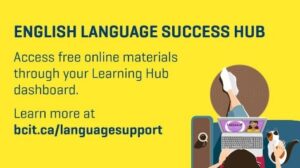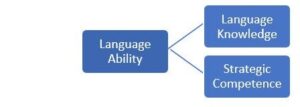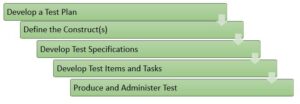Relevant research, publications, and talks by project team members
Research
Devos, N. J., Nizonkiza, D., & Lynch, S. (2024).Developing and validating a post-admission screening-diagnostic assessment procedure to offer language support in college diploma programs. Canadian Journal of Applied Linguistics. https://journals.lib.unb.ca/index.php/CJAL/article/view/33259
Devos, N. J. (2023). Reading for the technical workplace: Developing a diagnostic reading assessment for understanding instructional texts. TESL Canada Journal. https://teslcanadajournal.ca/index.php/tesl/article/view/1583
Brooks, D., & Devos, N. J. (2023). Advancing academic language support at a Canadian polytechnic institute. Journal of Innovation in Polytechnic Education 5(1), 50-57. https://jipe.ca/index.php/jipe/article/view/153/78
Devos, N. J. (2019). Comparing first-term students’ English language proficiency at a Canadian polytechnic institute. BC TEAL Journal, 4(1), 53–83. https://doi.org/10.14288/bctj.v4i1.335
Presentations
Devos, N. J. (2018, April). Why we need post-admission language testing at BC post-secondary. [Presentation]. BC TEAL 2018 Conference. Vancouver, BC.
Devos, N. J. (2018, May). Creating a post-admission language test with a learning management system. [Presentation]. WAESOL Conference. Renton, WA.
Devos, N. J. (2019, March). Creating a socially responsible language diagnostic tool to support at-risk students at a Canadian technical college. [Work in Progress]. LTRC 2019. Atlanta, GA.
Peralejo, C., Devos, N. J., & Lynch, S. (2021, June). Supporting and assessing language learners post-admissions: Some ideas for practice. [Online presentation]. Food for Thought. Burnaby, B.C.
Peralejo, C. (2021). Accessible online learning environments: How accessible content can be beneficial for all learners, including EAL students [Online presentation]. Diversity Circles, Vancouver, BC.
Devos, N. J. (2021, December). Online language assessment for the classroom: Transferring theory of assessment development to online language assessment for practical use in the classroom. [Keynote Address]. December 8, 2021. Curriculum 4.0: Gestaltung von Hochschulen für die digitale Welt. University of Münster, Germany.
Devos, N. J. (2022, April). Read it, do it: Developing college reading assessments for student success in the workplace [Online Presentation]. BC TEAL 2022 Conference.
Devos, N.J., & Peralejo, C. (2022, April). Post-admission language assessment & support: Opportunities & barriers [Online Presentation]. BC TEAL 2022 Conference.
Brooks, D., Peralejo, C., & Devos, N. J. (2022, May). Writing great assignment instructions that improve students’ task performance [Workshop]. BCIT PD Day. Burnaby, BC.
Brooks, D. (2023, March). My journey mapping journey. [Lunch & Learn]. Food for Thought. Burnaby, BC.
Devos, N. J. (2023, March). Post-Entry Language Assessment & Support in Higher Education: Are They Worth Their While? [Presentation] AAAL Conference. Portland, Oregon.
Devos, N. J. (2023, May). Grammar accuracy as a screening tool for English language support in short-cycle tertiary education. [Presentation] BC TEAL 2023 Conference. Vancouver, BC.
Devos, N. J. (2023, June). Understanding second language students’ language development and becoming a linguistically responsive teacher. [Invited Guest Speaker]. Bodwell High School. North Vancouver, BC.
Interview
Devos, N.J. (2022). Looking Outward. TEAL News. Winter 2022. https://bcteal.org/bc-teal-newsletters-grid.php
Student’s View: My Experience with the Industry Partnership, by Kailin Wei

I took the Job Application and Interview Online Course this year. I found it very helpful because it prepared me well for the whole job application process, provided personal feedback, and gave me precious opportunity to have on-site practice with professionals from the industry.
This program helped me prepare well with the whole interview process. I attended 6 classes which taught me about job searching, analyzing job ads, writing resume, cover letter and so on. I think these workshops are very important. Before attending these classes, I found job application process was convoluted as I don’t know where to start. Luckily, the program is well-structured and taught me what I should do in each step. In addition, the class discussion was very engaging as well. For example, my classmates and I collaborated on analyzing job advertisement. Then, we presented our analysis in front of the class and received feedbacks from our instructor. Through these in-class exercises, I was able to put what I’ve learnt into practice which helped me to understand the knowledge better.
In addition to attending class, I received personal feedback about resume and cover letter from our instructor. After teaching us tips for writing resumes and cover letters, the instructor asked us to submit our resume and cover letter, and he provided us with his insightful feedback. Writing resume and cover letter was my nightmare before because I was worried about making grammar mistakes. This resume and cover letter assignment “pushed” me to overcome my concerns and laziness. Most importantly, the feedback I gained from our instructor were very useful and valuable. He was very patient with my grammar mistakes and made many helpful notes to help me improve. Hence, I think this is a very beneficial for someone
Last but not least, I had interview practice with professionals, which I think is one of the highlights from the program. After several months of the practice on the “paper”, I had a 1-to-1 mock interview for behaviors questions with our instructor. During this practice, our instructor asked me behavioral questions and provided on-time feedback on how to improve my answers. I also had an opportunity to have a mock interview with the real company, Clarius. I was very nervous about this interview practice because it was my first “interview” in the computing industry. Gladly, the interviewer was very nice and provided me with some hints when I did not get the questions. I also learnt many things from these mock interviews, such as being ready for the unexpected, and trying to structure my answers before I talk. I think this is a very precious opportunity for a new graduate because the more he/she practises, the more confident he/she is.
In conclusion, I think I had a very memorable and valuable experience in Job Application and Interview Online Course. I was taught how to do job searching, I had a resume and cover letter ready to use, and I had mock interviews with professions. It has been a pleasure to be a part of this course and I would highly recommend it for other students.
Kailin Wei has recently graduated from the Full-Stack Web Development program at BCIT
Students’ academic acculturation through storytelling, August 2022, by Deo

Sharing stories as weekly highlights can impact a student’s life. Both domestic and international students transition to a new life (academic acculturation) at the start of their university/college studies. Giving them a platform to share their stories appears to help them transition smoothly to this new culture, potentially contributing to their success. Check out Deo’s blog post about his experience with storytelling and his students.
Link: https://teachingblog.mcgill.ca/2022/08/23/students-academic-acculturation-through-storytelling/
Student View: Preparation and Practice Interview with an Industry Partner, June 21, 2022, by Phu Doan

First of all, I would like to thank Language Success Team BCIT and my instructor for providing me with the opportunity to participate in this project. I also want to thank Lesley Starnes, Assistant Community Branch Manager of Vancity Brentwood Community Branch, for spending time interviewing me and giving me feedback on my performance.
I feel so lucky to have applied to this project when I first saw the announcement on D2L. After covering the basic concepts of a resume, cover letter, and interview in communication 2 class, I felt that I still needed more practice for a better understanding of this process in Canada. When I saw the advertisement, I immediately sent my application to the Language Success Team. This smart decision gave me more than I expected. With the enthusiastic assistance of my instructor, I have thoroughly learned about the interview process, from preparation to execution. Through the course, we have covered 6 topics in great detail. They are as follows: Creating a Personal Inventory and Your Brand; Searching for a Job in Canada; Understanding Job Ads; Writing Your Resume; Writing an Application Letter or Email; and Preparing and Practicing for Your Job Interview. More importantly, participating in this project allows me to practice with an industry interviewer. That experience showed me how to apply what I had learned in a real situation. Additionally, while interviewing with an industry partner, I understood deeper the expectations and requirements of the firm when they hire a new employee.
Besides all the benefits given, the instructor also provided us with the flexibility of time and location to study for this course. Every week we had a fixed online lesson with a length of 45 – 60 minutes. If we had any questions or needed a makeup class, the instructor was just one email away. That support allowed me to manage this project with compulsory courses at BCIT more effectively. Personally, to me, the instructor is not only an instructor but also a nice friend who is willing to help me with any problem inside or outside the boundary of the project.
On the interviewing day, because of the time difference between Vietnam and Canada, I had to wake up at 3 a.m. for the interview. Due to the lack of sleep, I was a little tired and fearful before the interview. However, after some short warmup questions with Lesley, I regained my confidence and completed the conversation smoothly. After the interview, I noticed that giving personal examples to illustrate answers is really important in an interview. Thus, I came up with an idea to create a folder in my note-taking system to consistently note my experiences. I will name this folder “Who am I?” to list all my personalities, strengths, and weaknesses, and then frequently update my real-life situation to show each trait. I believe this activity will give me more ideas to answer interview questions and sharpen my self-awareness and self-reflection skills.
Overall, I am grateful for the opportunity to participate in this project, and I believe that this course should be made widely available to students because it is a good preparation for students to become employees in the future.
Phu Doan is a first-year International Student from Vietnam in the Financial Management program.
Writing Great Assignment Instructions, May 2022, by David

During BCIT’s May 10 PD Day, the Language Success Team had the privilege of presenting a workshop entitled Writing Great Assignment Instructions That Improve Students’ Task Performance. But isn’t writing assignment instructions pretty straightforward? That’s a great question – glad you asked!
It is important to consider that what may be clear and obvious to us as fluent English readers might not necessarily be clear to our students. In fact, in our survey of 1,419 first-term BCIT students in Fall 2021, 42% of all students rated their own reading abilities as intermediate or basic. Therefore, reading ability and reading confidence may affect more than just our international students and newcomers.
By great assignment instructions, we mean those that are clear, concise and unambiguous. Often such instructions come about through a process of trial and error, trying them out with a class, and revising for next term. However, it can be helpful to start at the outset with some basic guidelines in mind. This can be especially important in the online environment, where students may not have the opportunity to ask clarification questions on the spot.
In writing assignment instructions, as much as possible we want to remove any barriers to comprehension. Two key guidelines that can help us do that are Structure and Language. Let’s look at each of these in turn.
Structure
- Provide assignment context. (Shapiro, Farrelly, and Tomaš, 2014)
How does this assignment fit into the course as a whole? How does it relate to previous and/or subsequent work students will do?
- Provide key assignment instruction components.(Shapiro, Farrelly, and Tomaš, 2014)
- Purpose and Goals
- Audience, Genre, and Format
- Grading Priorities (rubrics are helpful here)
- Process and Timeframe
- Keep in mind the power of visual elements.
- Use chunking for different sections of instructions
- Use layout features effectively, such as white space, headings, font size, etc.
Language
- Simplify the language. (Govender & Jaffer, 2021 and Nickl, 2018)
This does not mean dumbing down the language or leaving out essential components of instructions. It does mean using vocabulary and grammar which make the instructions more widely accessible to a diverse group of students:
- Vocabulary – use familiar, frequently used words
- Grammar – avoid complex structures; use direct language
- Reduce cultural bias. (Shapiro, Farrelly, and Tomaš, 2014, p. 46)
This does not mean we remove anything that refers to our own culture; after all, that would not be possible. It does mean that we examine our language for areas such as potentially unknown cultural references or idioms.
A little extra time spent in revising assignment instructions for structure and language will have significant payoff in allowing students to spend less time comprehending what they need to do and more time focusing on the task at hand.
For further details on this topic, including examples of revised instructions: Writing Great Assignment Instructions | The Loop (bcit.ca)
References
Govender, S. & Jaffer, T. (2021). Designing instructional text. In J. K. McDonald & R. E. West (Eds.), Design for learning: principles, processes, and praxis. EdTech Books. https://edtechbooks.org/id/designing_text
Nickl, M. (2018). 17. Instructional Texts – Learn How To Get Things Done. In J. Humbley, G. Budin & C. Laurén (Eds.), Languages for special purposes: an international handbook. Berlin, Boston: De Gruyter Mouton. https://doi.org/10.1515/9783110228014-017
Shapiro, S., Farrelly, R., & Tomaš, Z. (2014). Fostering international student success in higher education. TESOL Press. NAFSA.
Dr. Nathan Devos Gives Keynote Address in Germany, December 2021

In December 2021, Dr. Nathan Devos (Language Success Team Lead, SoCAS) was invited to give a keynote address on online language assessment at the Westfälishe Wilhelms-Universität in Münster, Germany. Other international speakers have also been invited to give presentations on their areas of expertise as part of a larger project on digitalization for future English teachers, funded by the Ministry of Culture and Science in North-Rhine Westphalia (NRW). Hosted by Dr. Julia Reckermann and Dr. Frauke Matz, the project’s aim is to foster more digitalization and online learning in Germany. Despite tight travel restrictions, Nathan was able to make it to Germany and be the project’s inaugural speaker.
Apart from his keynote address, Nathan’s visit also included four hours of video recording at a recording studio. The recording of his presentation will be edited and uploaded to an online database for teachers and students in NRW to access for professional development and studying purposes. Nathan offered advice on online English language assessment development and shared some experiences that the Language Success Team has made over the past seven months as they continue to research language assessment and support for BCIT’s English as an Additional Language (EAL) community. It was a great opportunity to represent BCIT, SoCAS, and the Language Success Term.
Nathan would like to thank the Language Success Team and BCIT International (International Mobility Fund (IMF) Committee) for supporting him in this short yet sweet international opportunity.
English Lounge – Building Community, December 1, 2021, by Cristina

This fall marked the launch of English Lounge, a free, English conversation group that meets on Burnaby campus on a weekly basis. The purpose of English Lounge is to provide a space in which participants can improve fluency, learn colloquial language, and make friends in an encouraging and supportive environment.
The idea to host English Lounge came about after conducting interviews with BCIT students last year about what kinds of language supports would benefit them (see May 14, 2021 blog post “Identifying Needs and Ideas” below). Many of them suggested that they would like the opportunity to meet other students who were struggling with their English and discuss issues that interested them, particularly after experiencing online learning as a result of the pandemic. Without the brief, informal interactions which typically occur after meeting for face to face classes, many students were feeling the burden of isolation and loneliness as they worked through course materials on their own.
What is an English Corner?
English “corners” or “clubs” began in China in Chinese universities. Gao (2009) defines English corners as regular meetings organized within China by EFL learners in order to practice oral English in public spaces. Many large cities in China have an English Corner and the majority of universities host them on campuses as well (Yang, 2014). While all English corners and clubs differ in their organization, they share some common features such as fostering a relaxed atmosphere, encouraging cooperative relationships between participants, and providing rich opportunities for language practice (Gao, 2009). In fact, after many years of English Corners being organized informally, Chinese universities have now come to recognize them as a meaningful way for students to improve their English due to their ability to provide students with “richer and more flexible environments for language acquisition and practical applications of English” (Yang, 2014).
English Corners remain very popular in China with good reason because English as a Foreign Language (EFL) students rarely get a chance to practice speaking in their classes because class sizes are large and much of their classes are focused on grammar and writing (Yang, 2014). Even though the situation is different at BCIT, we can make a case for English corners or clubs here as well. While students at BCIT are indeed surrounded by English, many students do not have opportunities to practice speaking English outside of the classroom and even sometimes inside the classroom as the information takes place in a unidirectional stream. At other times, class discussions might move too quickly for students to be able to join in. Above all, students may lack confidence—from confidence in their comprehension of the topic to their ability to pronounce words with accuracy.
Myles (2009) claims that having opportunities to speak outside the university classroom before entering work placements may eventually help EAL students with workplace acculturation. With BCIT’s emphasis on workplace preparation, English corners and clubs, and in our case, English Lounge, can prepare EAL students for both academic and workplace success by giving students the opportunity to gain confidence in their language skills, develop the knowledge and skills to manage cultural differences appropriately, and learn more about Canadian cultural behaviour.
English Lounge at BCIT—A Slow but Steady Start
Even though the students themselves recognized the need for English Lounge on campus, getting participants to English Lounge at BCIT has been a challenge. While the initial English Lounge started with eleven participants from a variety of technologies, English Lounge then averaged four to five students a week and dipped to below that during midterms. Despite the heavy demands of classes and midterm exams, a core group of 3-4 students have been holding steady since the very start of the term, showing an impressive commitment to improving their language skills. Their reasons for attending English Lounge vary. Some are newly arrived international students undergoing their first term at BCIT, so they come to English Lounge to find new friends. Others are feeling the pressure of graduation looming and seek to improve their language skills before they start their job search. Many participants indeed express frustration at the lack of opportunity they have to express themselves inside and outside the classroom.
English Lounge alternates between fluency practice, functional language (such as opinions, agreeing, disagreeing), and idiomatic language. Participants speak in pairs and small groups so as to maximize speaking opportunities. Some of the topics that have been discussed include: Canadian culture, immigration, environmental concerns, and common challenges students face. Participants come from a range of ages and cultural backgrounds, so they enjoy exchanging cultural perspectives and making cross-cultural comparisons. From these discussions, a sense of community has emerged, where students listen to each other’s struggles and offer support, encouragement, and advice.
Some of the future goals for English Lounge include growing the number of participants, encouraging students to become more involved in the running of the Lounge, and expanding English Lounge to other BCIT campuses. English Lounge runs every Wednesday on Burnaby Campus, from 2:45-3:45 at the Summit Centre (the back of the main floor of the library). If you, or someone you know is looking for a chance to practice speaking English, the door is always open.
References
Gao, X. (2009). The ‘English corner’ as an out-of-class learning activity. ELT Journal, 63(1), 60-67. https://doi.org/10.1093/elt/ccn013
Myles, J. (2009). Oral competency of ESL technical students in workplace internships. The Electronic Journal for English as a Second Language, 13(1), 1-24. https://eric.ed.gov/?id=EJ898196
Yang, N. (2014). Principles and strategies for English corner construction at universities. Canadian Social Science, 10(4), 71-81.
Launching New English Language Support Initiatives, September 23, 2021, by Nathan

August and September were busy months for the Language Success Team. We had spent a good part of summer developing, revising, trialing, and finally launching our new English Language Support initiatives, including a revised version of our online language assessment, the English Language Success Hub, and the English Lounge.
The revised online language assessment (also known as English Screening Test for Polytechnics-Online, ESTP-O) was released to 23 full-time BCIT programs on August 19. For 16 programs, this included a two-part screening component followed by a writing diagnostic. The purpose of the assessment is to help identify students who may benefit from attending weekly, free Language Support classes. This also assists instructors in starting Language Support classes earlier in the term. Most importantly, however, it lets students know that there are support services available to them if they’re seeking help in English. In total, about 1,400 student completed the assessment by September 17. (You can also check out Sarah’s previous blog post on test development for more info.)
Meanwhile, the English Language Success Hub launched on August 26. This online portal is a free, self-access course for students to brush up on English skills or discover some additional interactive resources to help improve their English preparation for BCIT courses. There are four language learning modules, including sentence-level writing, vocabulary, and pronunciation, as well as one that covers some common grammar errors. By the second week of September, we had about 150 students who had completed at least one module, and there has been some great community building on the “Nice to meet you!” page as students introduced themselves and offered advice and shared experiences on learning English. Check these out at English Language Success Hub.
The English Lounge has also started this month. We’ve had a slow start but hope that we’ll get a small turnout as students settle into their schedules. The English Lounge is space for students to come, have casual conversations, and practice their listening and speaking skills in an informal environment. It takes place in SE14 on the second floor (Summit Centre) every Wednesday from 2:45-3:45.
The English Screening Test for Polytechnics – Online (ESTP-O), August 19, 2021, by Sarah
The ESTP-O is a post-admissions language assessment that measures the communicative English language ability of first-year BCIT students whose programs offer Language Support classes. The purpose of the test is to identify students who may benefit from additional, weekly Language Support classes during their studies. It is based on Bachman and Palmer’s (1996; 2010) widely used model that defines communicative language ability as the ability to understand and communicate in a language, which involves both knowledge of the language and strategic competence in its use (as illustrated in Figure 1).
Figure 1
Components of Communicative Language Ability

How was the ESTP-O developed?
The 2021 version of the ESTP-O underwent a rigorous process of test development. The stages are depicted in Figure 2.
Figure 2
Stages of Test Development

Note: Adapted from Cheng and Fox (2017) and Lane et al. (2016)
The first step was to develop the test plan. This involved articulating the purpose of the test, identifying an appropriate model of communicative language ability (i.e., Bachman and Palmer, 1996; 2010), deciding on the components of the language test, and providing a rationale for each component.
After the test plan was developed, we defined the constructs to be measured. Our definitions came from Purpura (2004) and Knoch (2011), who researched and articulated the finer-grained concepts of communicative language ability from Bachman & Palmer’s model.
Once the theoretical frameworks had been chosen, test specifications were developed. Test specifications are a blueprint for a test that detail all the information about a test: the purpose, the population, the constructs measured, the item format (e.g. multiple choice, cloze, essay, etc.), the scoring, etc.
After the specifications were created, test items and tasks were developed. Items from previous versions of the test were analysed and those that had the desired statistical properties were identified for possible reuse. New items were then developed and piloted with volunteers from first-year BCIT courses in summer 2021. This allowed us to gather information about the statistical quality of the new test items and revise them accordingly. Items typically have to be revised and piloted several times to produce the desired statistical properties. Therefore, the pilot items that were revised will be repiloted in the future. During the pilot phase, students also completed a survey and provided feedback on the test.
After we selected items and tasks for the test, it was produced in the Learning Hub. This involved careful consideration of accessibility, layout, instructions, and images. Feedback on test design from students in the pilot was carefully considered. The online test then underwent several quality control checks to ensure the various components were functioning appropriately prior to administration.
How is the ESTP-O organized?
The ESTP-O is comprised of two components: a screening test and a diagnostic test. The screening test measures students’ English language knowledge because this is what underlies language use. The screening test aims to differentiate between students who are proficient users of English and those who are still developing their English language ability. The latter group may be offered Language Support. The subsequent diagnostic test measures students’ language knowledge and strategic competence in writing. It aims to pinpoint specific areas for improvement, and to inform the students, Language Support Instructors and Language Success Team’s Curriculum Development Specialist so that these areas can be further developed. Students who demonstrate sufficient English language knowledge on the screening test are not asked to complete the diagnostic test.
When do students take the ESTP-O?
The ESTP-O is administered post-admission, just prior to the beginning of term 1 classes. This concurs with research that suggests early intervention is important for first-year students.
References
Bachman, L., & Palmer, A. (1996). Language testing in practice: Designing and developing useful language tests. Oxford University Press.
Bachman, L., & Palmer, A. (2010). Language assessment in practice: Developing language assessments and justifying their use in the real world. Oxford University Press.
Cheng, L., & Fox, J. (2017). Assessment in the language classroom. Palgrave. https://doi.org/10.1057/978-1-137-46484-2
Knoch, U. (2011). Rating scales for diagnostic assessment of writing: What should they look like and where should the criteria come from? Assessing Writing, 16, 81-96. https://doi.org/10.1016/j.asw.2011.02.003
Lane, S., Raymond, M. R., & Haladyna, T. M. (2016). Test Development Process. In S. Lane, M. R. Raymond & T. M. Haladyna (Eds.), Handbook of test development (2nd ed.) (pp. 3-18). Routledge. https://doi.org/10.4324/9780203102961
Purpura, J. (2004). Assessing grammar. Cambridge University Press. https://doi.org/10.1017/CBO9780511733086
Student’s View: My Interview Practice with an Industry Expert, June 2, 2021, by Denis Chsherbachuk

First, I would like to express my gratitude to BCIT for the opportunity to participate in this project. Especially to my instructor Nathan Devos for his work in preparing me for the interview with Clarius. And of course, thanks to Clarius for kindly agreeing to participate in our project, and in particular to Kris, VP Research & Development, who found the time to interview me.
A Communication class was included in my curriculum at BCIT, which introduced me to the basic concepts and requirements when writing a Resume, Cover Letter, and showed me examples of formal communication with colleagues in the workplace. However, the Job Application and Interview Online Course introduced me to a set of different techniques that improved my existing skills and supplemented them with new knowledge. I learned how to find the job ads that most match with my skill set, as well as analyze them, and highlight the key points that answer questions such as: What character/personality traits should the applicant have? What technical skills are they looking for? What might the company culture be like? and etc. This is a very important skill that helps to understand the company’s needs and values and gives me an idea of what the employer expects from me.
An equally important skill is to understand your strengths and be able to correctly reflect them in your resume. It is necessary to use an analytical and creative approach when writing a cover letter in order to interest the employer in your candidacy from the first lines. And here Nathan showed not only his professional qualities but also turned out to be a nice person. All our classes were held in a friendly manner, 45–60-minute sessions flew by as 5 minutes, which allowed me to feel comfortable and helped me to reveal my full potential.
During this course, we analyzed examples of various resumes and cover letters. After that, we learned how to format and organize a resume. We designed a cover letter writing plan, Nathan introduced me to the STAR approach, which stands for Situation, Task, Action, Result. It is a great way to tell a school or work-related story or describe any situation or project. It is a versatile technique that can always come in handy. We discussed and analyzed possible interview questions, worked on manners and word- choosing, and also conducted an entire session devoted to interviewing practice. Nathan has provided me with many helpful instructional videos that we discussed together after watching.
One blog post is not enough to list all the skills that I have acquired by participating in this project. Overall, I believe the Job Application and Interview Course should be offered to more students as it provides an invaluable and unforgettable experience.
[Denis is a first-year Electrical Engineering student at BCIT. He’s 20 years old and grew up in Kazakhstan. He’s been in Canada for less than 5 years]
Identifying Needs and Ideas, May 14, 2021, by Cristina

The Why
As the Language Learning for Newcomers project ramped up, it became clear that in order to define the basic groundwork for the curriculum development side of the project, it was necessary to identify needs and ideas from the points of views of both instructors and students. Specifically, we were interested in finding out perceptions towards language learning and language support courses and what both groups imagined language support could look like in the future.
In order to determine this, I interviewed a number of language support instructors and students, and the Language Support Team distributed a survey to all students who had been recommended for language support, regardless of whether they had attended the classes or not.
Speaking with Instructors
It was a pleasure to speak with instructors and note how much they enjoyed teaching the Language Support courses despite its challenges. It was clear that they enjoyed working with the students in a more intimate setting and being able to watch them grow and improve as the months passed. Though the structure of the Language Support course different from program to program and from instructor to instructor, some core similarities remained. In general, instructors primarily support and scaffold the assignments given in the COMM courses and also work on students’ language development simultaneously.
Instructors mainly identified gaps in students’ writing, particularly in terms of grammar. Many also mentioned that students requested and needed repetitive practice of a skill and exposure to many examples. A few instructors mentioned that reading comprehension is a difficulty for students, especially reading instructions in assignments and tests. Finally, one instructor pointed out that students may benefit from information on study skills such as time management.
Instructors provided a great deal of insight into what support would be most useful in the future for themselves and for the students. This included:
- Banks of mini-lessons that can be customized across programs and departments
- An organized databank of materials to be used in Language Support courses
- Asynchronous materials which they could refer students to in the future
- Building a community for students to feel comfortable participating in
Interviewing and Surveying Students
Besides the survey which was sent out to all students who been identified for language support, I also had the opportunity to interview small groups of students in order to discuss their perceptions of their language support classes. The students I talked with were quite enthusiastic about their language support courses. They were happy to receive additional support with their COMM assignments, and to see how the grammar they studied applied to particular assignments. Another aspect they enjoyed was receiving personalized feedback from their instructor and peers in a safe setting. These positive attitudes towards language support were also clearly seen in the survey results:


The majority of students surveyed claimed they experienced difficulty in writing grammatically accurate sentences and organizing their ideas logically when writing, which confirmed the responses given by instructors. However, students also pointed to difficulties that they faced in all their skills throughout all their courses, not just their COMM courses. I was surprised to note that receptive skills, especially reading were highlighted by the students. Students claimed that reading exam questions and instructions on assignments were particularly challenging. Another challenge they identified both in interviews and in survey responses was speaking clearly so that instructors and classmates could understand them.
I concluded the interviews by asking students what kind of support might be useful to them in the future, and this question was also echoed in the survey. Many of the students interviewed remarked that it was helpful for instructors to provide guidance to them on where and how to begin improving their language skills as they felt lost as to where to begin. Survey respondents also indicated that self-paced, online materials on the Learning Hub would be a useful tool to have. Finally, the interview groups and the survey respondents were generally in favour of participating in a conversation circle with peers.
Next Steps/ Recommendations
It is clear that language support classes greatly benefit those students who attend them, and it is also clear that students need to be supported in all of their skills. While the language support courses provide ample opportunities for students to work on written output, students identified issues in reading assignments as well as being able to speak in class with confidence. As well, considering that BCIT focuses greatly on workplace skills and that students appreciate the practical nature of their studies, it is also clear that any materials created have to be grounded in workplace culture, and students need to be made aware of how what they are learning applies to skills they will require in the job market. Finally, learners often want to improve their English, but often do not know where to start. Providing a road map for learners will be key to our next steps in this project.
Some of the next steps involved are to:
- Develop sample modules for the asynchronous student shells
- Develop corresponding sample modules for the instructor shells
- Request and receive feedback on what has been created
- Begin to flesh out a suggested curriculum for language support instructors grounded in the information gathered from the diagnostic assessments
Project Receives $500K from the Future Skills Centre, April 9, 2021, by Nathan

After waiting several long months for this to happen, our funding partner, the Future Skills Centre, finally announced the projects they’re funding across Canada. We’re proud to be one of 64 projects (selected from over 400 applications) to receive federal funding for our project “Language Learning for Young Newcomers.” Check out this interactive map of projects on the Future Skills Centre website.
Working on the application over the summer, I really hoped that we would get the boost we needed to push the project to the next level. I’d been working with other Communication instructors over the past years, but I knew that we had started to grow so big in terms of our testing capacities, number of recommendations, and how we thought we could best support our EAL students. We were essentially bursting at the seams. For example, the number of students we had screened in September 2020 had tripled since 2018, from about 400 to 1,200 students. We also recommended 300 students to Language Support and helped over 150 throughout the Fall 2020 term, so this federal funding was timely and needed. Now, we can’t wait to grow and support more students in different ways.
Since the official announcement, we’ve received so much support for this project from across BCIT; check out the great, positive comments on LinkedIn.
Link to BCIT News Release: https://commons.bcit.ca/news/2021/04/researchers-receive-funding-shock-proofing-future-of-work/
BCIT Hangouts, February 11, 2021, by Nathan

Today I got to hang out with some great student life advocates and talk about my favourite topics: Second Language Learning and Language Support.
Second language learning is a journey that has an impact on us emotionally, mentally, psychologically, and socially. In this video, I share about my own personal journey of studying in Germany for 5 years (in German), even though I didn’t know any German before I went.
I also talk about the benefits of attending language support, and that a small investment of time can go a long way in improving your grades.
Click on the link below to watch the full video:
BCIT Student Life Office – Second Language Learning & Language Support at BCIT | Facebook